Health
Ed Skrein ‘Rebel Moon’ Workout: How He Cut to 5% Body Fat

British actor Ed Skrein is brilliant at playing both heroes and villains, but there’s no question he’s better known for his baddies. Time and time again, he’s showcased an innate ability to captivate and unnerve with his performances, which is no doubt why he was called upon by Zack Snyder to play the ruthless Admiral Atticus Noble in the director’s epic Rebel Moon saga.
For Skrein, the role was an opportunity to showcase his acting chops and cut an intimidating figure. He started the extreme fitness transformation months before with long-time trainer Matt Lovell, nutritionist Erin Blevins, and muay Thai coach Yusuf Ali-Taleb. The result is a performance and physique as powerful as any special effect out there.
The ideal body type for a villain differs drastically, but for Rebel Moon, Skrein wanted to achieve a “tight, taut look, almost like a snake.” He whittled down his body fat percentage to 5 percent.
Note: There are downsides to having an extremely low body fat percentage. Anything under 5 percent can cause waning energy, risk for heart issues, and low testosterone. Skrein was only at 5 percent for shoot day, and normally walks around at 12 percent. If you’re seeking the right body fat percentage to see abs, aim for 6 to 13 percent, the latter of which is much easier to maintain.
Men’s Journal talked to Skrein about how martial arts helped him mentally and physically for the role and nabbed a sample workout the actor used to burn fat and build muscle.
Rebel Moon—Part Two: The Scargiver is now streaming on Netflix.
Men’s Journal: You’ve worked with some great directors over the years, but Zack Snyder has made a unique mark. What was it like working with him?
Ed Skrein: Zack cares deeply about every element of his films. There’s a reason he casts the people he does, and he expects a lot from them. The physical element is just as important as everything else on set. From the beginning that was made clear, and I could tell he trusted me to bring the right result in front of the camera. The words Atticus Noble says and the way he says them is no more important than how his body looks in those moments.

Courtesy Image
What were you trying to achieve, aesthetically, for the character of Atticus Noble?
I wanted people to lean back in their chairs when I came on the screen. I wanted them to think, “This guy is scary and weird.” I didn’t want muscles for nothing. I wanted this tight, taut look, almost like a snake about to strike. There are all kinds of villains out there. Do you think a big, puffy guy is scary? Personally, I think when you see someone who’s really lean and sinewy, that’s scary. That’s a person who’s desperate but also dangerous. That’s why I wanted the vascularity that you see.
What made this snake-like transformation possible?
Before this role came to me, I’d been speaking with my London muay Thai coach Yusuf Ali-Taleb [about how] I wanted a project I could really train for. I’d done so much work on my fighting, switching positions, and striking. I’ve been training [in] muay Thai for almost a decade at this point, and I think martial arts training was really beneficial for the character. That’s how I wanted him to be able to strike, so we trained hard together for this.
I was also going to the gym with my trainer and friend Matt Lovell, who also handles my supplementation. We’ve been working together for a while, and I was excited to have a reason to really get some muscles. We leaned into the resistance work as well. We go to Muscleworks gym in London for our sessions, and I love the community there.
Related: The 60 Best Action Movies of All Time, Ranked
How did it compare with other training you’ve done in the past?
I’ve done marathons, triathlons, and swam the English Channel from England to France without a wetsuit. I still think this may be the hardest thing I’ve ever done. I had to go back and call on the mental effort that was required during Channel crossing. I remember just having to go arm after arm, coming up for air, and being tossed around by the waves. Those moments of hell on Earth. Those experiences are how I have gotten the resilience I needed to get through training and filming this. At the same time, I’m not sure what my mental health would have been like without being able to go to the gym on set.
Zack Snyder is renowned for how he runs sets. What was it like working on Rebel Moon?
I think it’s clear to anyone who’s watched a Zack Snyder movie the scale of his productions is always massive. He creates something completely different. The best part was seeing the gym Zack built. The machines were incredible and there was so much space. I mean, it was the dream.
I knew for sure then that Zack was my kind of director. And I think he brought me in because he knew I was his kind of actor as well. There was a trainer on site called Alessandro, who was there to support some of the actors. I was already on my own training trajectory at that point, but it was awesome to get in there and train with some of the crew.
The most wonderful thing was the sense of community. I was happy to not be lonely. So many times it’s been a very solitary pursuit, training to the level that I do for these projects. That was not the case here, Zack was our leader on set and in the gym. I had met my match in that aspect. I was also in there with Alfonso Herrera, who plays Cassius; Stuart Martin, who plays Den; Sky Yang, who plays Aris; and Ray Fisher, who plays Darrian Bloodaxe. Bae Doona was in there as well.

Courtesy Image
How did you feel about the results?
It reminded me that I’m 41 years old. I beat myself up and I felt it. But there was also a part of me that was like, “Look, you young fuckers, this is how a man trains.” It took another level of discipline. If there are actors who are okay with doing the bare minimum, that’s fine. But I’m not trying to do that ever, I wanted to take it to the furthest level. I probably went a little too hard, to be honest. But that’s the way I like to do things. Especially with a character who is as extreme as Noble.
It sounds like you went to the edge. What was your mindset like to keep that up?
I have to admit there were times during this process where I had to ask myself, “What is your problem?” There was nobody asking me to push it to that level. There was really no reason I was so beat up by the end of the shoot [that] I couldn’t even sit at the dinner table. I was lying on the floor with my dinner plate next to me because I destroyed my back the day before. Hitting a few painkillers, then going back to do the job again the next day.
I have massive respect for bodybuilders and the fighters who train in my gym. But for most of them, they are prepping for their competition for a certain amount of weeks and they’re doing one well-timed water cut. I was doing this for seven months, and doing water cut after water cut for the scenes that needed it. This was a different kind of hell. I couldn’t show one body on camera, then not show the same thing in the next scene. I was using water and salt to get the exact look I needed. One day I’m doing seven pages of dialogue fully suited up in a military uniform, and a few days later I’m completely undressed, showing everything.
Do you think the mental part of training that hard affected how you played the character?
I looked unhinged on-screen, and I probably was a little unhinged from all of the overtraining I was doing. I don’t believe the performance would have been quite as good if I hadn’t taken it to that level, and when I see the book of photos that Zack Snyder shot, I had no idea my body could even look like that. In the end, it was worth it. And it’s made me enjoy training even more.
These days I’m still working out six days a week, and I have my nutrition locked in. In my garden, I have steel maces and kettlebells, which I was taught to use by my crew at Onnit. And now if I want to have an old fashioned, I’ll have an old fashioned. Maybe a glass of the whiskey Zack founded, which he gave to me after wrap…have a little excess to toast the times of minimalism. I’ll probably open that when the extended version of Rebel Moon comes out. Host a little party.
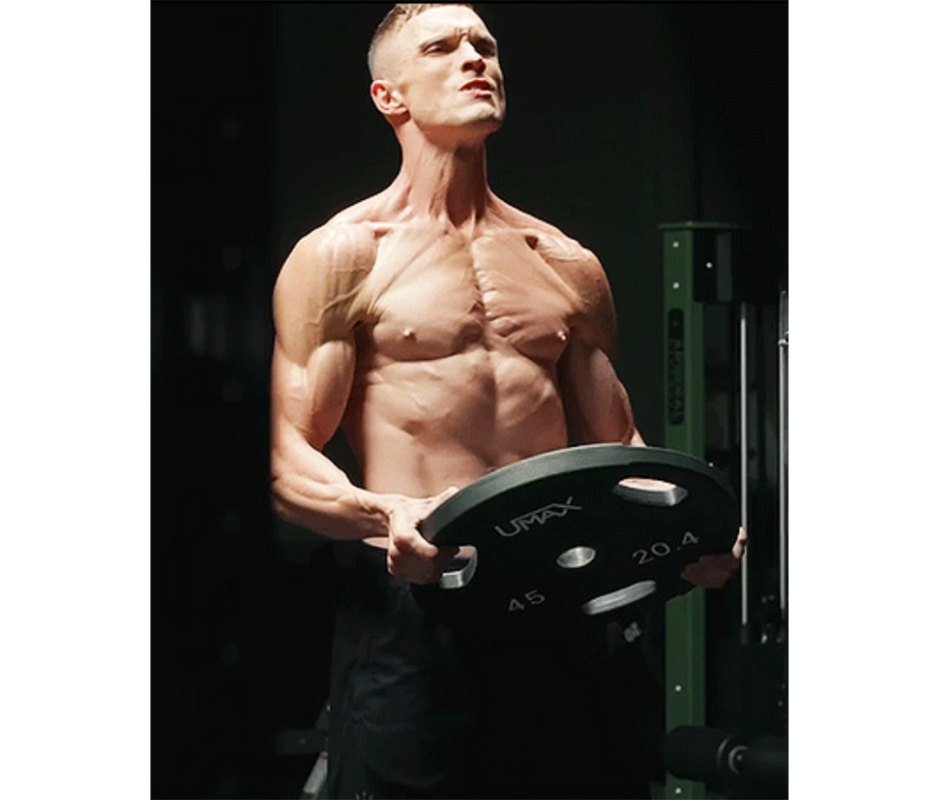
Courtesy Image
Ed Skrein Rebel Moon Workout: The Routine That Got Him Shredded Down to 5% Body Fat
Directions
This is a sample chest, back, and core day Skrein did with trainer Matt Lovell in London before hitting the Rebel Moon set. This kind of programming was paired with long martial arts sessions with muay Thai coach Yusuf Ali-Taleb. Be explosive in the concentric phase of the lift (when you flex or lift weight up), then go slow and controlled on the eccentric phase (lowering).
Begin with a dynamic warmup, then move into the warmup sets, completing 2 rounds with a kettlebell. The workout comprises 10 exercises total, paired in supersets, meaning you’ll perform both exercises back-to-back with no rest in between. The supersets are done with a descending rep count, while adding 20 pounds of weight before beginning the next superset. Rest for 30 seconds between each superset.
Warmup
Directions: Perform 2 sets. Rest for 30 seconds between each set.
1. Goblet Squats x 10 Reps
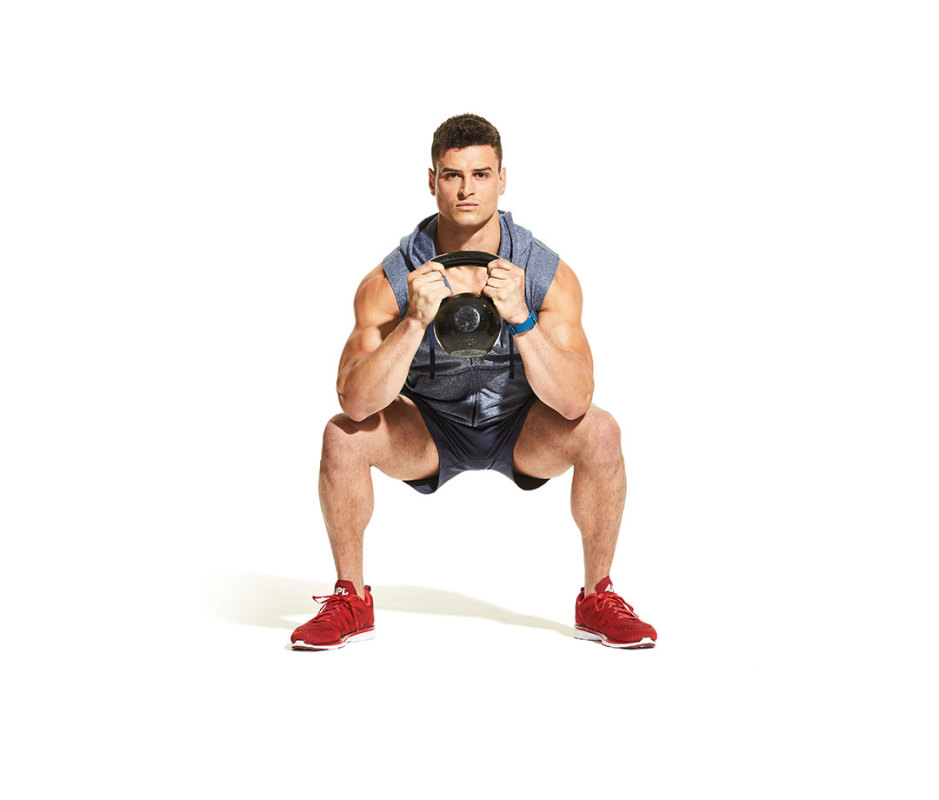
James Michelfelder
How to Do It
- Stand with feet shoulder-width apart and toes pointed out slightly, to start.
- Clean a kettlebell to your chest with both hands on the horns.
- Engage your core and hinge your hips to lower slowly into a squat, keeping your spine neutral.
- Pause at the bottom, then explode up to the starting position.
- That’s 1 rep.
2. Single-Leg Deadlift x 10 Reps Each Side
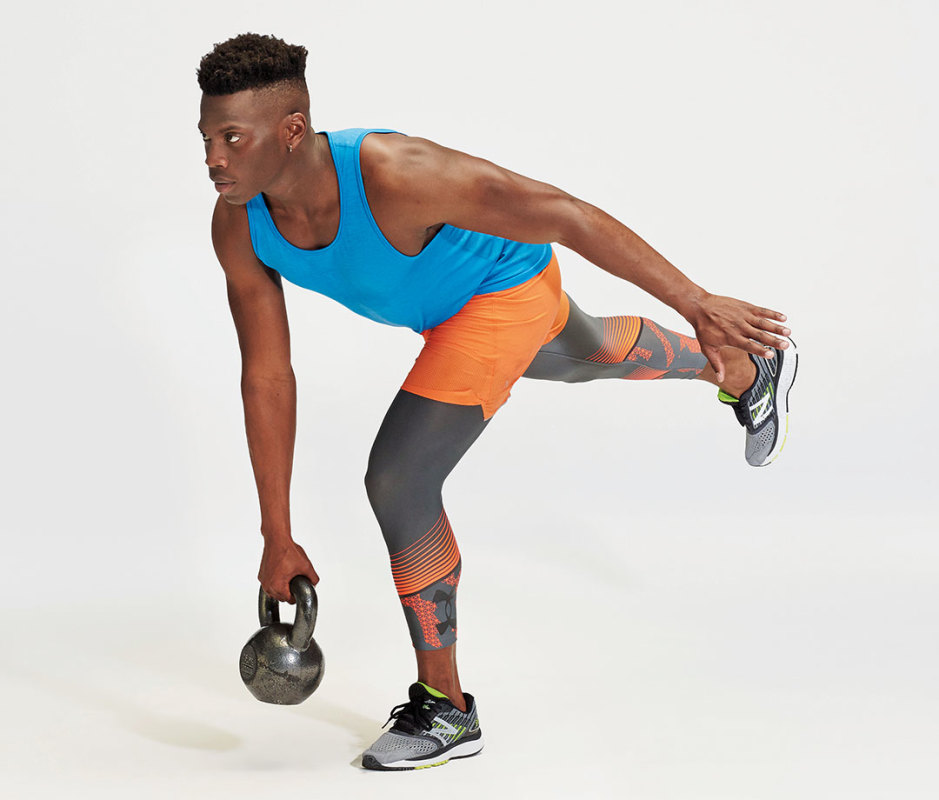
Justin Steele
How to Do It
- Stand with a kettlebell in your right hand, resting in front of your thigh, palm facing you, to start.
- Hinge at the waist as you bring your right leg straight back, maintaining a soft bend in your left leg as you slowly lower the weight toward the ground.
- Stop when the kettlebell reaches your shin and your torso is parallel to the ground.
- Push through your left leg and explosively extend through hips to stand.
- That’s 1 rep. In the second set of 10 reps, switch arms.
Related: 7 Ways to Get a Shredded Body in a Week
Ed Skrein Rebel Moon Workout
Directions
Perform 5 rounds of each superset below before moving to the next superset, increasing the weight by 10 pounds for each weighted exercise, before doing the next set. Rest 30 seconds between supersets.
1A. Dumbbell Bench Press x 15, 12, 10, 8, 6 Reps
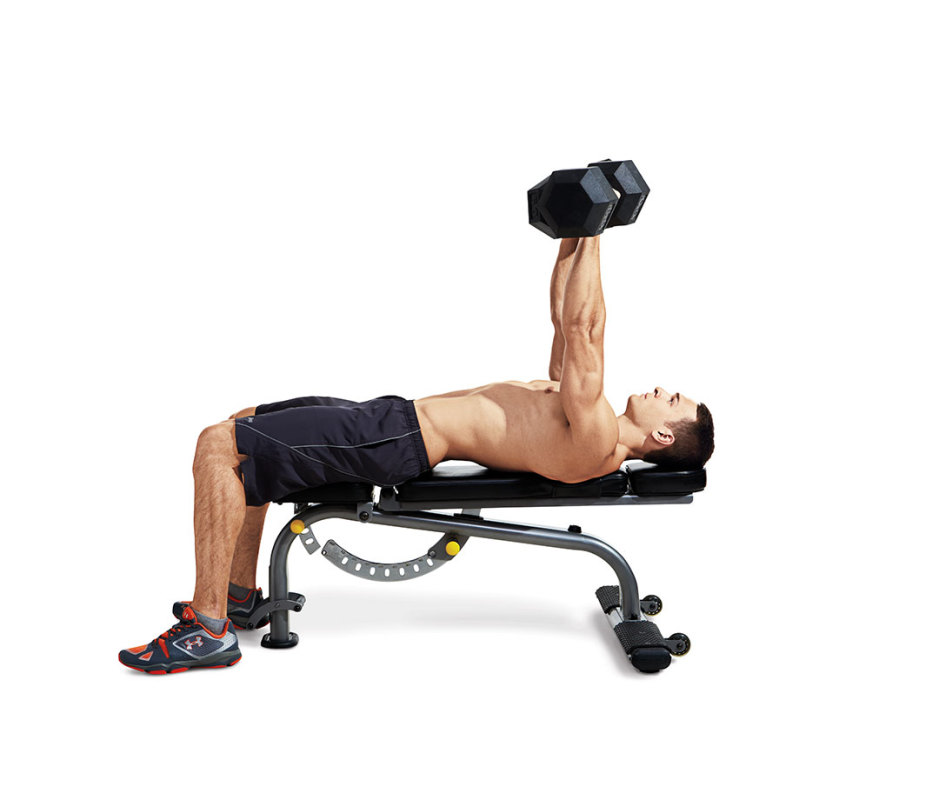
Beth Bischoff
How to Do It
- Sit on a flat bench holding two dumbbells on your thighs with a neutral grip, to start.
- Kick your knees up to hoist the bells over your chest as you lie down.
- Slowly lower the dumbbells to your chest, then explosively press them up driving your feet into the ground.
- That’s 1 rep.
1B. Chinups x 15, 12, 10, 8, 6 Reps
James Michelfelder
How to Do It
- Stand below a pullup bar, to start.
- Grasp the bar with an underhand grip with hands shoulder-width apart (or wider).
- Engage your lats by pulling your shoulder blades down your back, then engage your biceps to pull your body up until your chin is over the bar, keeping your core engaged and eyes forward throughout.
- Pause at the top, then slowly lower down to a dead hang. That’s 1 rep.
2A. Incline Dumbbell Press x 15, 12, 10, 8, 6 Reps
James Michelfelder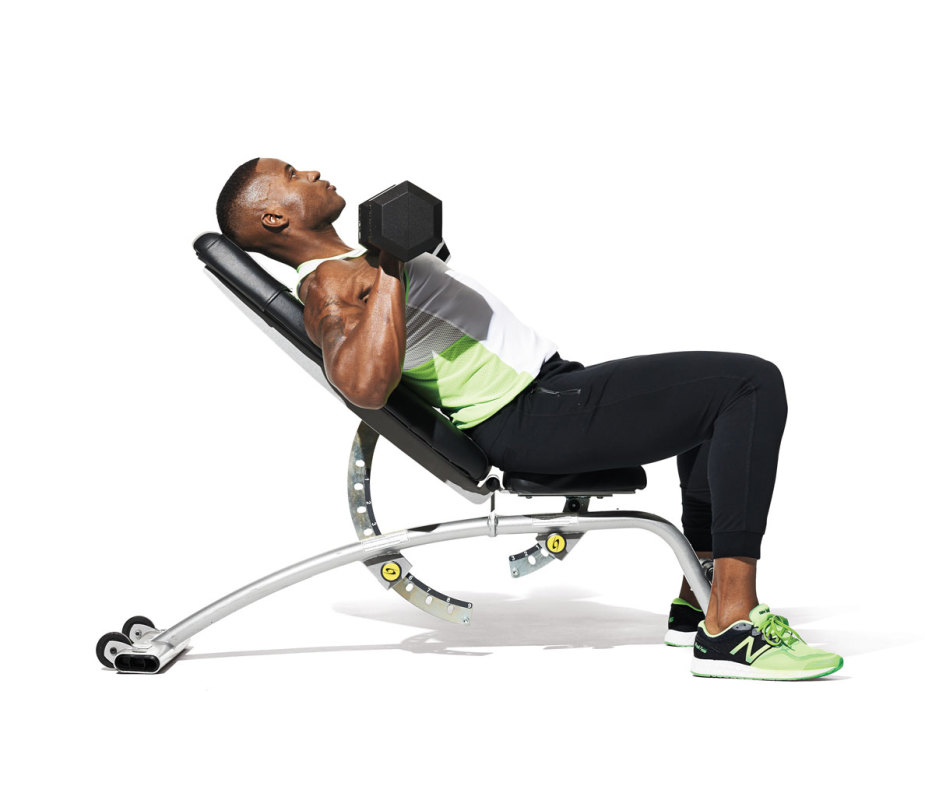
How to Do It
- Sit on an adjustable weight bench, set at a 45-degree angle, holding two dumbbells on your thighs with a neutral grip, to start.
- Kick your knees up to hoist the dumbbells into position and lie back against the bench.
- Inhale, then press the bells straight overhead until arms are fully extended, exhaling at the top.
- Pause briefly, then slowly lower to the start position. That’s 1 rep.
2B. Lat Pulldown x 15, 12, 10, 8, 6 Reps
James Michelfelder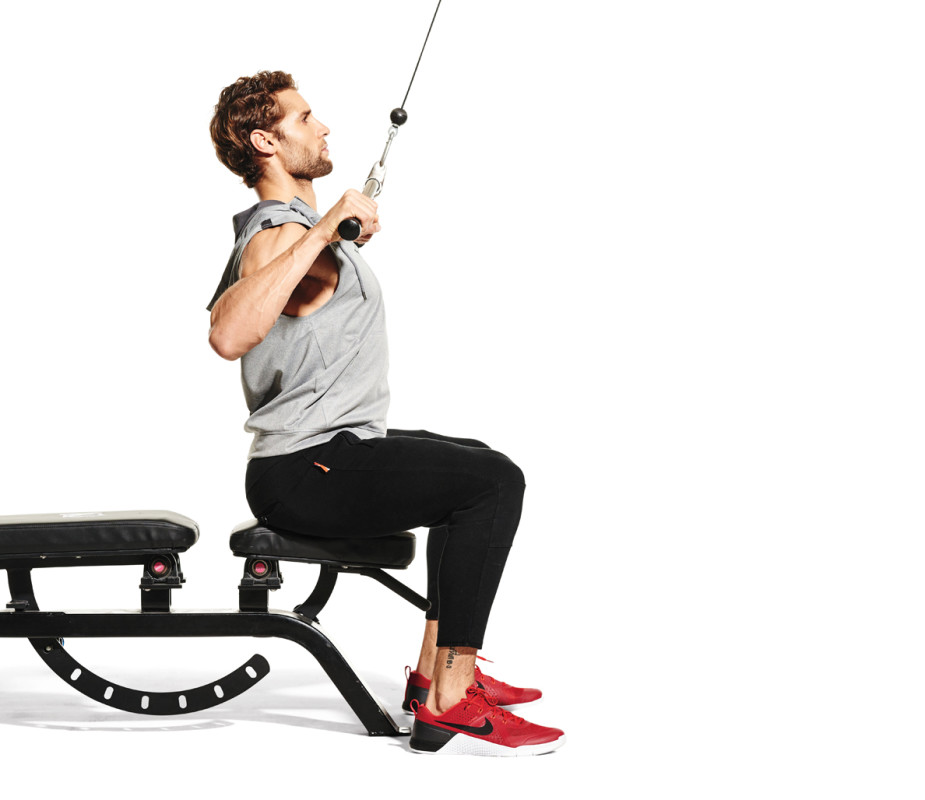
How to Do It
- Sit down at a lat pulldown machine with knees bent and feet firmly planted on the ground, to start.
- With an overhand grip, grab the handle with hands just wider than shoulder-width apart.
- Engage your core and pull your shoulder blades down your back, then slightly lean back as you explosively pull the bar down until it hits the top of your chest.
- Pause briefly, squeezing your shoulder blades together, then slowly let the weight return to the start position. That’s 1 rep.
3A. Dumbbell Pullover x 15, 12, 10, 8, 6 Reps
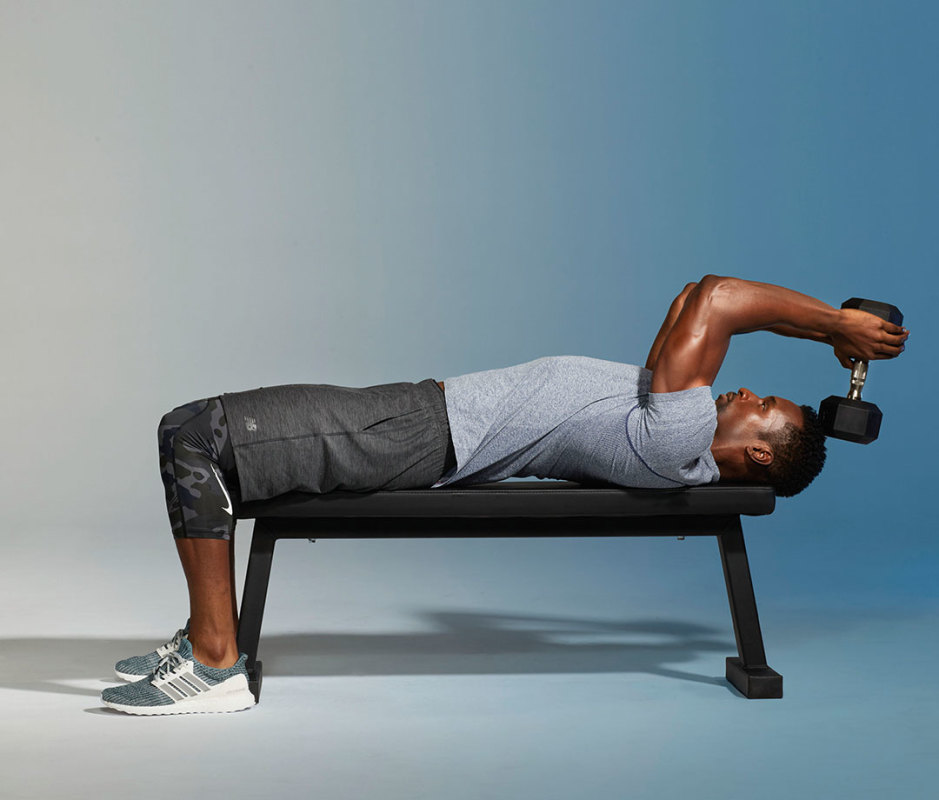
Justin Steele
How to Do It
- Lie flat on a bench holding a dumbbell with arms straight over your chest, to start.
- Keeping your upper arms in the same position, slowly lower the weight until your elbows are bent 90 degrees. This targets the lats.
- Conversely, you can keep your arms straight and pull the dumbbell behind your head to hit the pecs and serrates anterior.
- Explosively pull your arms back to the start position, straightening your elbows. That’s 1 rep.
3B. Behind-the-Neck Chinup x 15, 12, 10, 8, 6 Reps

James Michelfelder
How to Do It
- Stand below a pullup bar, to start.
- Grasp the bar with an underhand grip with hands shoulder-width apart (or wider).
- Engage your lats by pulling your shoulder blades down your back, then engage your biceps to pull your body up.
- Instead of a traditional chinup, bring your head forward while keeping your neck straight, so the bar touches the back of your neck.
- Pause briefly at the top, then lower to the start position in a controlled manner. That’s 1 rep.
Health
How to Create and Deliver High-quality Student Interventions

Student interventions are an essential part of any K-12 education system. Each student’s needs are unique, and some students might need additional guidance beyond what they get through whole class instruction. A multi-tiered system of supports (MTSS) or a Response to Intervention program (RTI) ensure that students’ various learning needs are addressed, allowing everyone to thrive.
In a tiered intervention system, all students receive core instruction. Those who need more help in meeting academic or behavioral goals then receive additional instruction in a small group environment, such as in reading or math groups. Students who need further help might receive one-on-one support through specialized instruction, behavioral support, or even replacement instruction as necessary. Along with instructional practices, the learning environment can support intervention.
Whether the interventions are academic, social emotional, or behavioral in nature, high-quality student intervention systems all share some key characteristics. Here are four critical strategies for designing and delivering student interventions that lead to success.
Information is Power
For interventions to be effective, educators must identify every student’s strengths and needs, then match each child with an appropriate intervention, monitor their progress, and make adjustments as needed. This requires educators to collect and analyze social-emotional, behavioral, and achievement data for every student on an ongoing basis.
The Center on Multi-Tiered System of Supports from the nonprofit, nonpartisan American Institutes for Research (AIR) describes four essential components of an MTSS framework.
Screening
This is a systematic process for identifying students who might be at risk for not meeting learning outcomes. Screening is generally conducted three times a year through reliable and valid assessment tools.
Multi-level Prevention System
This is an integrated continuum of academic, social emotional, and behavioral instruction and intervention that includes three tiers of intensity.
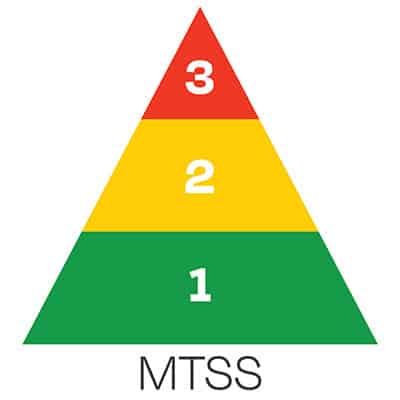
Progress Monitoring
This involves the use of valid and reliable assessment tools to monitor students’ progress, gauge their response to interventions, and evaluate the effectiveness of these supports. If students aren’t making sufficient progress, they might be paired with a different intervention or moved from Tier 2 to Tier 3 intervention.
Data-based Decision-making
All of this activity relies on the collection and use of student performance data, including grades, test scores, teacher observations, and the results from student screening and progress monitoring.
It Takes a Village
Decisions about which students need which types of interventions are best made collectively, with a student support, success, or intervention team regularly reviewing the data and discussing the best course of action for specific students.
Teams should include representation from a broad array of roles and perspectives, including administrators, counselors, and both regular and special education teachers. The process should be collaborative, with everyone on the team having a voice. The most successful teams are made up of volunteers, so leaders should try to assign members who genuinely want to participate.
The Center on Multi-Tiered System of Supports provides guidance on creating effective school-based intervention teams.
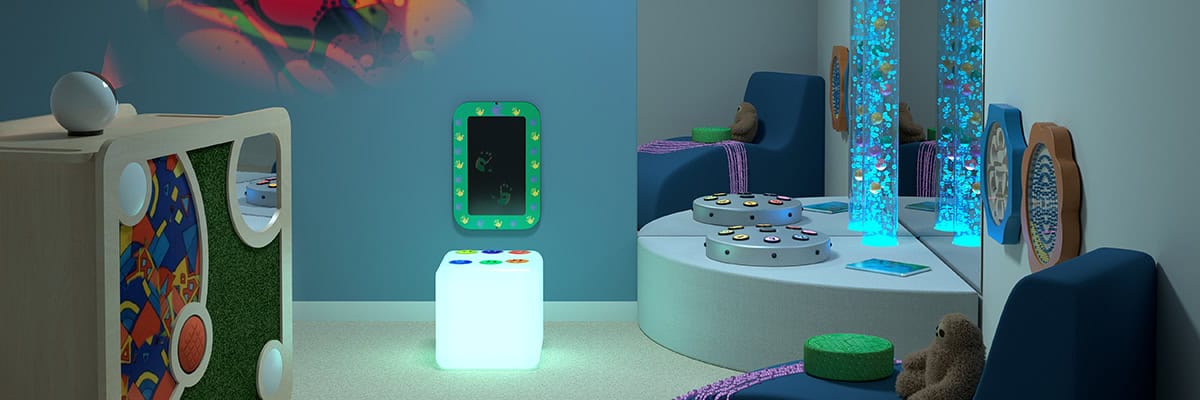
Effective Interventions Require High-Quality Resources and Environments
This might seem obvious, but you can’t deliver effective interventions without high-quality (and evidence-based) instructional resources to support them. The right resources can foster creativity and self-expression, which are essential components of social emotional learning. The learning environment should also be utilized to support instruction and intervention. Ensuring that the environment supports instruction allows students to build agency for their learning, collaborate, and have choice and voice to learn where they best learn is critical to support the instructional practices.
Research indicates that the design of the physical learning environment has a big influence on both the type and quality of instruction that occurs in that space. To maximize the effectiveness of student interventions, think about the design of the classrooms and other spaces where this learning occurs. Learning environments can be designed to support student interventions at each tier of instruction.
In Tier 1, for instance, flexible furnishings that can be moved around the room easily to create various student groupings make it easy to transition from whole group to small group instruction or even individual learning. The right type of classroom design can also promote student wellness and social emotional learning. In this tier, a school might also consider how they encourage social interactions and collaboration by providing a “hallway hangout” with soft seating or small group work areas. Schools may want to consider the use of acoustics to quiet noise in a more public area. These areas may also be used with tier two interventions.

Tier 2 environments can allow students to take respite or support the need for a quiet space to work. This can be a chill corner in the back of a classroom that has soft seating, fidgets, or even sensory panels. Again, some of this instruction at tier two can benefit from using a “hallway hangout” space for small group or individual support.
Students who need Tier 3 behavioral intervention might benefit from spending time in a Snoezelen® multi-sensory room. Students with sensory processing concerns may benefit from interventions focused on proprioceptive input, vestibular input, or oral motor, language, or auditory skills. A Snoezelen® multi-sensory room allows a student to control their environmental inputs by changing the colors or sounds in the room, among other things.
Fostering Success
With interventions playing an increasingly important role in K-12 instruction, how you design and deliver these programs is fundamental to student success. By following this advice, you can develop highly effective student intervention programs that enable everyone to flourish.
Dr. Sue Ann Highland
Sue Ann Highland, PhD, is the National Education Strategist for School Specialty. She has more than 25 years of experience as an educator, administrator, and consultant with school systems across the United States, with broad expertise in designing and creating highly effective learning environments.
Read more by Dr. Sue Ann Highland–>
Health
How to help your teen manage college rejection disappointment – CHOC

Published on: May 9, 2024
Last updated: April 16, 2024
A CHOC mental health expert offers tips for parents to help their teens with college rejection disappointment.
Link: https://health.choc.org/how-to-help-your-teen-manage-college-rejection-disappointment/
Health
Taking Racism out of the Kidney Disease Equation

The first sign something was wrong with Curtis Warfield came in 2005, when a lab test found protein in his urine during a routine checkup. In 2012, Warfield was diagnosed with stage 3 kidney disease. Two years later, he started dialysis.
“When you get diagnosed, you’re sitting there kind of like a deer in headlights. You don’t know what’s going on. You don’t know what’s coming next,” Warfield said. “All you know, you have this disease.”
Warfield, a Black man, was 52 years old, had been healthy, and had no family history of kidney disease. As his condition worsened and he worked his way through treatment options, he experienced a form of racism without knowing it: a math equation that counted his race when it estimated his kidney function.
That equation, called the estimated glomerular filtration rate or eGFR, is an important variable that helps dictate the course of treatment for an estimated 37 million people with kidney disease across the country. The eGFR equation estimates how well a person’s kidneys are filtering blood, taking into account a person’s age, gender, and levels of creatinine, a waste product naturally made by people’s bodies that is cleared out through the kidneys. But it has long involved a controversial variable: race.
If a person self-identifies as Black, the equation adjusts their score, increasing it. No other races are counted in the equation. As a result, Black people have higher eGFR scores than people of other races. Those scores, which estimate how well kidneys are functioning, influence doctors’ treatment recommendations. The lower the score, the more likely a patient is to begin dialysis or even to receive a kidney transplant.
As the disparities facing Black people with kidney disease became more widely studied, the race-based eGFR has been increasingly challenged by nephrologists, high-profile kidney disease organizations, and, crucially, medical students who questioned their educators about the biological basis for differentiating between Black and non-Black people.
Warfield has been advocating for other people with kidney disease since he received a transplant in 2015. He joined a multi-organization task force spearheaded by the National Kidney Foundation in 2020. The task force spent months diving into the issue, challenging the inclusion of race in the eGFR, and ultimately initiated two new equations for estimating kidney function.
The new, race-neutral equations came out this past fall. And in February, the United Network for Organ Sharing (UNOS), the nonprofit organization that manages the organ donation and transplant system in the U.S., proposed dropping the use of the racialized eGFR in favor of a race-neutral eGFR. As a result, kidney care in the U.S. is at a watershed moment of moving past a deeply entrenched, institutionally racist equation.
Dropping the race factor from kidney estimations is a crucial step in reducing disparities in kidney disease and treatment, according to specialists on the National Kidney Foundation’s task force. Black Americans are at a disproportionate risk for conditions that contribute to kidney disease, like high blood pressure, diabetes, and heart disease. While Black people make up less than 14% of the population in the U.S., they encompass 35% of people on dialysis, according to the National Kidney Foundation.
“People that are Black are much less likely to be referred to transplant even when they are on dialysis. When referred, they’re much less likely to be listed. When listed, they’re much less likely to be given a kidney transplant. There are disparities every step of the way,” said Rajnish Mehrotra, MD, chief of nephrology at Harborview Medical Center and a University of Washington professor of nephrology and medicine.
Those disparities were the basis of increased questions from medical students over the past several years, Mehrotra said, particularly when it came to the equation the students were learning to assess kidney function.
“They were told in the class that there’s an equation in which it reports a different number if you’re Black versus if you’re not Black. And they challenged the premise of that, as in like, ‘What is the evidence that there is a difference there?’’ Mehrotra said. “And so the deeper we dug in terms of searching for the evidence to support a differentiated reporting by race, we came to the assessment that the evidence supporting that is not strong at all.”
University of Washington Medicine, where Mehrotra works, became one of the first institutions to do away with the race variable of the eGFR equation back in June 2020.
But there was a broader movement going on as well, involving the premier professional societies for kidney specialists, the National Kidney Foundation and the American Society of Nephrology, as well as patient advocates (including Warfield), clinicians, scientists, and laboratory technicians, all convening with the goal of phasing out the racialized eGFR in favor of a race-neutral approach.
In June 2021, a year after Washington Medicine dropped the racialized eGFR, the task force formed by those organizations released an interim report questioning the use of race as a factor in diagnosing kidney care.
The race variable in the eGFR had come about based on research from the 1990s, according to the report. Published in 1999, the Modification of Diet in Renal Disease (MDRD) study was one of the first to include Black people – an earlier kidney function estimation equation was based entirely on white, male patients’ information – and it found higher levels of serum creatinine among Black adults than their white counterparts, the task force authors write in their report.
At the time of the MDRD, making a mathematical adjustment based on race was seen as an advance because including Black people in studies at all was an advance, according to the report.
But within the MDRD is a troubling justification for higher creatinine levels among Black people: earlier studies had shown that “on average, black persons have greater muscle mass than white persons.” The three studies cited there, published in 1977, 1978 and 1990, compared different health measures, including serum creatinine kinase and total-body potassium levels, in Black and white study participants. The studies all state that separate reference standards are needed for Black people, attributing differences in results to differences in racial biology.
Today, those conclusions would be challenged.
“Our understanding of race has evolved over the last quarter century,” said Paul Palevsky, MD, the president of the National Kidney Foundation and a professor at the University of Pittsburgh, one of the primary organizations in the task force. “Rather than being biologically based, race is much more of a social construct than anything else.”
In September 2021, the task force released their two new equations that estimate kidney function. Neither uses race as a factor. One is very similar to the racialized eGFR, which measures creatinine. The other equation adds a second test that measures cystatin C, another chemical in the blood that serves as a filtration marker.
Both equations have been recommended because even though creatinine testing is available at virtually all laboratories across the country, cystatin C is not, leading to a higher price tag and decreased access to the test. The process to move laboratory practices toward the new standard is underway, said Palevsky, and he’s hopeful that the major labs will make the change over the next several months.
“In medicine, the time that it normally takes from when a clinical practice guideline or recommendation is published to when it really seems to enter into clinical care is about a decade,” Palevsky said. “In this case, what we’re seeing is a very rapid implementation of the new equation.”
The new equations are slightly less precise compared with the old equation, Palevsky and Mehrotra agree. But the estimates are just that – estimates – and should be used as just one part of a much more comprehensive clinical analysis of a person’s health and needs.
And as racial disparities across medicine continue to be studied and understood, the impacts of factoring in race in health care decisions can have a corrosive effect beyond an individual person and their diagnosis, Palevksy said. “As we teach medical students and residents, if we use race-based algorithms, we are reinforcing for them this concept, this false concept, that race is a biological determinant of disease, which it is not,” Palevsky said.
Systemic racism factors into Black people’s health outcomes in many different ways, from chronic stress of experiencing racism to limited access to healthy food to bias of health care providers. These problems are deeply entrenched and require their own sustained solutions.
The new eGFR equation, though, is a step in the right direction, Palevsky said.
“Will it solve the problem of disparities in kidney care? I think we would be deluding ourselves to think that a simple change in an equation is going to solve much, much deeper-rooted problems,” Palevsky said. “Certainly just changing an equation isn’t going to solve the problems of disparities, many of which are rooted in historic racism.”
Those disparities will only be meaningfully lessened by large-scale investment into the health of poor communities. But the eGFR equation is a meaningful step for Black people with kidney disease, nonetheless. The benefits of the new eGFR equation, Warfield said, expand beyond the equation itself.
“It’s opening eyes and doors to other disparities that are going on, at least within the kidney community, and getting people to talk about and look at what all is going on,” Warfield said. “It’s good to have to know that the patient’s voice is now sitting at the table and being listened to, and not just decided by the medical community.”
-

 African History3 months ago
African History3 months agoBlack History Facts I had to Learn on My Own pt.6 📜
-

 African History4 years ago
African History4 years agoA Closer Look: Afro-Mexicans 🇲🇽
-

 African History1 year ago
African History1 year agoPROOF AFRICAN AMERICANS AIN'T FROM AFRICA DOCUMENTED EVIDENCE
-

 African History2 years ago
African History2 years agoHow Did Normal Medieval People Survive Winter? | Tudor Monastery Farm | Chronicle
-

 African History3 years ago
African History3 years agoThe Entire History of Africa in Under 10 Minutes – Documentary
-

 African History3 years ago
African History3 years agoWhat happened to the many African Kingdoms? History of Africa 1500-1800 Documentary 1/6
-

 African History2 years ago
African History2 years agoAFRO MEXICO: Black History In Mexico!
-

 African History1 year ago
African History1 year agoA Black African King in Medieval European Art
























